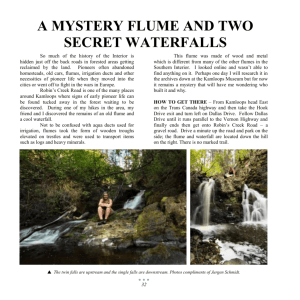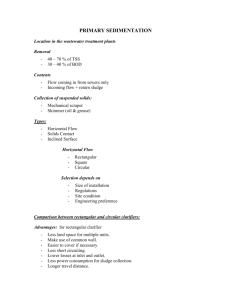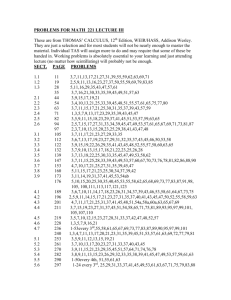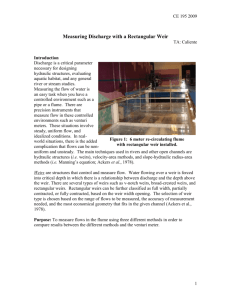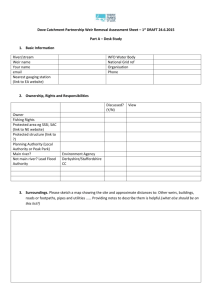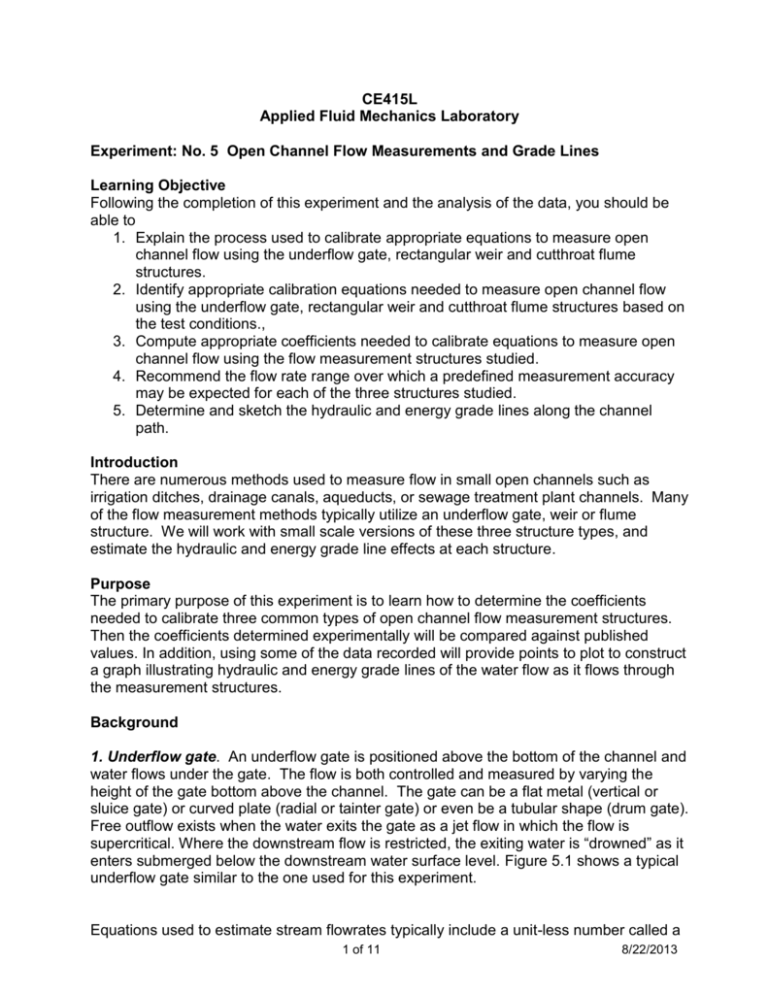
CE415L
Applied Fluid Mechanics Laboratory
Experiment: No. 5 Open Channel Flow Measurements and Grade Lines
Learning Objective
Following the completion of this experiment and the analysis of the data, you should be
able to
1. Explain the process used to calibrate appropriate equations to measure open
channel flow using the underflow gate, rectangular weir and cutthroat flume
structures.
2. Identify appropriate calibration equations needed to measure open channel flow
using the underflow gate, rectangular weir and cutthroat flume structures based on
the test conditions.,
3. Compute appropriate coefficients needed to calibrate equations to measure open
channel flow using the flow measurement structures studied.
4. Recommend the flow rate range over which a predefined measurement accuracy
may be expected for each of the three structures studied.
5. Determine and sketch the hydraulic and energy grade lines along the channel
path.
Introduction
There are numerous methods used to measure flow in small open channels such as
irrigation ditches, drainage canals, aqueducts, or sewage treatment plant channels. Many
of the flow measurement methods typically utilize an underflow gate, weir or flume
structure. We will work with small scale versions of these three structure types, and
estimate the hydraulic and energy grade line effects at each structure.
Purpose
The primary purpose of this experiment is to learn how to determine the coefficients
needed to calibrate three common types of open channel flow measurement structures.
Then the coefficients determined experimentally will be compared against published
values. In addition, using some of the data recorded will provide points to plot to construct
a graph illustrating hydraulic and energy grade lines of the water flow as it flows through
the measurement structures.
Background
1. Underflow gate. An underflow gate is positioned above the bottom of the channel and
water flows under the gate. The flow is both controlled and measured by varying the
height of the gate bottom above the channel. The gate can be a flat metal (vertical or
sluice gate) or curved plate (radial or tainter gate) or even be a tubular shape (drum gate).
Free outflow exists when the water exits the gate as a jet flow in which the flow is
supercritical. Where the downstream flow is restricted, the exiting water is “drowned” as it
enters submerged below the downstream water surface level. Figure 5.1 shows a typical
underflow gate similar to the one used for this experiment.
Equations used to estimate stream flowrates typically include a unit-less number called a
1 of 11
8/22/2013
Experiment: No. 5 – Open Channel Flow Measurements
CE 415L
discharge coefficient. The discharge coefficient, Cd, is used to account for several factors
that are difficult to determine analytically, including the viscous and surface tension of the
flow and the height of the downstream fluid level vs. the height of the gate opening.
The value of the discharge coefficient is derived experimentally and is primarily
dependent on the exit conditions presented by the downstream fluid level. It is crucial to
recognize that the discharge coefficient you find experimentally will probably only be valid
for similar downstream conditions.
Two general types of downstream conditions are denoted as follows
If the fluid exits the gate as a jet and is only subject to atmospheric pressure then
a free flow condition exists.
If the fluid exits the gate submerged by tail water a drowned flow condition exists.
Sections of flow to be analyzed
1
2
3
A
A
Flow
b
y y2
Approximate shape of
surface under drowned
flow conditions
y1
y3
yg
Plan View
Section A-A
Figure 5.1 - Underflow Gate
Approximate shape
of surface under free
flow conditions
The equation of the discharge for the gate developed from Bernoulli’s energy equation,
customarily used where free flow conditions exist, is:
Q Cd * yg * b 2 g * y1
Q
Cd
yg
b
g
y1
(Eq. 5.1)
Flow rate (ft³/sec)
Discharge coefficient (dimensionless)
Height of gate above channel bottom (ft)
Width of channel (ft, assumes gate width is the channel width)
Acceleration due to gravity (32.2 ft/sec2)
Height of head upstream of the gate (ft)
Note that this equation is similar in form to the orifice equations used elsewhere in
hydraulics engineering.
An alternate method used to approximate the flow rate where drowned outflow conditions
exist uses a pair of equations (Eq. 5.2 and Eq. 5.3) that must be solved simultaneously for
Q and y:
2 of 11
8/22/2013
Experiment: No. 5 – Open Channel Flow Measurements
CE 415L
Flow from section 1 to 2
Q2
Q2
y1
y
2 gb 2 y12
2 gb 2 y22
(Eq. 5.2)
Flow from section 2 to 3
y32
y2
Q2
Q2
2 gb 2 y2
2 gb 2 y3
(Eq. 5.3)
where
y = the submerged depth immediately downstream of the gate (ft)
y2 = the height (head) of the minimum depth of free flow immediately downstream
of the gate (ft), estimated to be Ccyg (where Cc is assumed to be 0.61 for this
experiment)
y3 = the height (head) downstream of the gate after the hydraulic jump (ft)
NOTE: Please sure to observe the relative height relationship between y and y3.
You may need to use this as a constraint when you solve Eq. 5.2 and Eq. 5.3
simultaneously.
The discharge coefficient will vary with the height, y3, of the downstream fluid level.
2. Rectangular weir. A weir is an obstruction placed on the channel bottom with the top
extending vertically some distance from the bottom over which the stream must flow. The
shape of the flow area in the plane of the weir plate is used to determine the type of weir
being used: rectangular, triangular, and trapezoidal. Weirs may be sharp-edged (sharpcrested), rounded, or broad-crested. Moreover, each weir type will have unique features
and produce effects that make it more or less suitable for specific applications. A
rectangular weir, like the one used in this experiment is typically a structure constructed of
concrete or other durable material with vertical upstream and downstream faces between
which a flat and level surface forms an elevated plane that the water flows over.
Rectangular weirs are easily duplicated and are generally used for flow rate
measurement. However, each weir must be carefully calibrated for the expected flow
rates since many factors create a complex analytical problem. A weir in which the crest
width (transverse to the water flow) is equal to the channel width is referred to as
suppressed; if the crest width is less than the channel width it is called a contracted weir.
Figure 5.2 shows a typical suppressed rectangular weir similar to the one used for this
part of this experiment.
The rectangular weir can be used to measure relatively large flow rates compared to
other weir types such as sharp-crested weirs. However, the accuracy of flow rate
measurements also depends on the ratio h1/L as summarized in Table 5.1.
3 of 11
8/22/2013
Experiment: No. 5 – Open Channel Flow Measurements
CE 415L
weir crest
2.5hw
A
A
FLOW
L
nappe
h1
b
V1
hw
y
yp
Plan View
plunge pool
depth
Section A-A
Figure 5.2 - Suppressed Rectangular Weir
Table 5.1 – Rectangular weir classifications (Chin 2006)
h1/L
weir
classification
h1/L<0.08
long-crested
Subcritical flow
over the weir crest.
broad-crested
Critical flow is near
the middle of the
weir crest.
0.08≤ h1/L≤ 0.33
flow condition
flow rate measurement
suitability
The weir is of limited use for
flow measurements.
Variation of Cw with h1/L is
small so reliable flow
measurements can be
made.
Critical flow
Not stable enough for
location and length
reliable measurements.
may not be stable.
For the rectangular weir used in this experiment the weir discharge equation is
h1/L >0.33
Q Cw
Q
g
b
H
Cw
narrow or sharp
crested
3
2
g *b * ( H )2
3
(Eq. 5.4)
Flow rate (ft³/sec)
Acceleration due to gravity (32.2 ft/sec2)
Width of channel (ft, assumes weir crest width is the channel width)
Total head over weir (ft) (see Eq. 5.5)
Discharge coefficient (dimensionless)
The discharge coefficient, Cw, is used to account for several factors that are difficult to
determine analytically, including the viscous and surface tension of the flow, the height of
the backwater level vs. the height of the weir as well as the ratio of h1/L.
The weir discharge coefficient, Cw, is primarily dependent on the total head (H, Eq. 5.5)
of the water at the upstream face of the weir and includes the height of the water above
the weir and the average approach velocity (V1, Eq. 5.6). The total head is typically
measured at a distance of about 2.5*hw upstream from the upstream face of the weir
where the water surface profile is relatively level.
4 of 11
8/22/2013
Experiment: No. 5 – Open Channel Flow Measurements
CE 415L
2
V
H h1 1
2g
V1
(Eq. 5.5)
Q
b* y
(Eq. 5.6)
Note that y is the full depth of the water at the point where h1 is measured.
3. Flumes. Another common method used to measure flow in open channels is with
flumes. Flumes are structures placed or formed into the stream channel and work by
forcing the fluid to accelerate as it passes through the tapered (width) constriction created
by the flume structure. The constrictions may narrow the channel, re-shape the slope of
the channel bottom, or use a combination of both. By narrowing the channel or changing
the bottom slope the water surface elevation following the constriction (the control point)
falls relative to the elevation leading to the constriction which results in the flow changing
from subcritical to supercritical flow. Flumes are frequently used in channels for irrigation
supply and wastewater processing.
A few examples of flume shapes are shown in Figure 5.3. Some of the main advantages
of flumes compared to weirs are that the head loss is less and flumes can be designed to
pass sediment, which can help prevent clogging and periodic maintenance required for
sediment removal.
Certain design parameters of the flume must be carefully considered and designed to
prevent the flume outflow from becoming submerged to ensure that the outflow remains
supercritical. The practical importance of this is that as long as the water leaving the
flume is at a lower elevation than at the entrance and is flowing at supercritical velocity,
the tail water conditions (following the flume) will not have much effect on the head water
elevation across the range of flow rates for which the flume is intended to operate.
The flume used for this experiment is most like the cutthroat flume shown in Figure 5.4.
The name denotes that it is similar to the Parshall flume (which is one of the most
commonly used types) but the vertical profile changes through the throat bottom are “cut
off”. It is sometimes used to save construction costs (compared to the Parshall flume) and
where downstream conditions can be relied on to maintain supercritical flow immediately
following the flume. In our lab setup it is placed just before the vertical drop inlet at the
end of the channel. Since the water surface elevation changes throughout the flume
structure and for some distance before it, the water surface height, h1, should be
measured at a distance of 20 to 30 times the width of the control point. Because of
equipment space limitations, the flow rate through the flume will be calibrated using the
water surface height at a point upstream of the flume entrance where the water surface is
level.
5 of 11
8/22/2013
Experiment: No. 5 – Open Channel Flow Measurements
CE 415L
Figure 5.3 – Flume shape examples (USBR 1993)
A
A
Subcritical Flow
w
X = 20W to 30W is recommended,
but it may not be practical for this
experiment.
Supercritical Flow
Plan View
control point
h1
h2
Section A-A
Figure 5.4 – Flume dimensions
6 of 11
8/22/2013
Experiment: No. 5 – Open Channel Flow Measurements
CE 415L
Calculating the flow rate as a function of the water surface elevation, h1, is relatively
simple provided that the outflow is not submerged. The basic equation for a cutthroat
flume with a control width of less than 1 foot is
Q ah1
b
Q
a
b
h1
(Eq. 5.7)
Flow rate (ft³/sec)
a constant, typically between 0.5 and 2.0
a constant, typically between 1.0 and 2.0
depth of water entering the flume (ft)
Outflow is considered submerged for flumes with a throat width of less than 1 foot if the
ratio of the water surface elevation at the discharge is equal to or greater than 0.6 times
the height of the water surface entering the flume. This should be checked during the
experiment to ensure that the outflow is not submerged at any flow rate.
4. Hydraulic and Energy Grade Lines
The water surface profile itself can be of interest in many engineering scenarios. For
example, storm water (SW) and wastewater (WW) sewers are typically designed for
gravity flows. Only in special cases are they designed to properly function if the water
becomes pressurized. The elevation of the water surface profile can be estimated at any
point in the system by computing and plotting the hydraulic grade ine (HGL). The HGL
includes the head (energy) due to the depth of the water in the pipe or conduit and the
bottom of the pipe or conduit above the system datum elevation. To avoid allowing the
water to become pressurized and thus creating problems in the gravity flow system, SW
and WW system designers work to ensure that pipes are sized and aligned so the HGL
does not reach the intrados or top of the inside of the pipe or above some distance below
a manhole cover. If the velocity head component is added to the hydraulic grade line, the
result is the energy grade line (EGL). The EGL can be used to keep track of total energy
and energy losses in the system to avoid undesirable effects on the system. One such
undesirable condition that can be caused by an excessively low EGL would be where the
velocity of the water carrying solids slows to the point that the solids drop out and
accumulate further reducing the capacity of the pipe. You should refer to the text book or
other references for more discussion about HGL and EGL.
Procedure
Refer to the equipment manual for layout of the open channel demonstrator.
The basic procedure is to perform the setup and make initial gate, weir, flume and
channel measurements. Start the pump and wait until the flow rate and water surface
elevations become stable. For each flow rate indicated by the inline flow meter, record
the flowrate and the water surface elevations at each key point for all three flow
measurement structures. After all data are recorded, complete the calculations to fill the
tables, write the report and answer the questions.
7 of 11
8/22/2013
Experiment: No. 5 – Open Channel Flow Measurements
CE 415L
1. Adjust the underflow gate opening to 5/8 ± 1/16 inch.
2. Be sure the rectangular weir and flume structures are firmly anchored to the
channel.
3. Measure channel, gate, weir and flume dimensions.
4. Fully close (CW) the 1-1/2 -inch globe and 3-inch globe valves.
5. Turn the main AC and slope motor breakers ON.
6. Adjust the slope of the channel to be as near level as practical.
7. Turn the pump motor ON. Open the 1-1/2 -inch globe valve fully for the maximum
flow rate. Allow the channel flow to stabilize, this should take about one minute.
Call this the 100% flow rate.
8. While waiting for the water surface elevations to stabilize, position the two
ultrasonic fluid level meters to measure the water surface elevation upstream of
the weir and upstream of the flume. Be sure to follow the suggested water surface
measurement locations for the respective flow structures.
9. Once the water surface profile appears to be stable, measure and record the
observed flow rate and water surface profile dimensions needed for each flow
structure.
10. Photograph the profile of the water surface in the channel. Position the camera so
that the photograph shows the surface of the headwater in the tank behind the
gate near the left-hand edge of the picture and the flow exiting the flume is visible
near the right-hand edge of the picture. It may be helpful to include brightly colored
objects to help identify those points in the photograph.
11. Adjust the flow rate by closing the 1-1/2-inch valve incrementally. Make the
adjustments so the indicated flow rate is at approximately the 90%, 80%, 70%,
60%, 50%, 40%, 30% and 20% relative to the initial maximum flow rate (but do not
use a flow rate less than 5 gpm due to measurement errors that may occur in the
flow meter). Allow the channel flow to stabilize at each step before taking the water
surface measurements. Since the flow meter updates at 5-second intervals, you
should wait 10 to 15 seconds after changing the flow rate before making
measurements.
12. Repeat steps 9 and 11 until measurements at all the flow rates have been
completed. The water profile photograph is only needed for the highest flow rate
case.
13. Drain water from the channel and dry the channel bottom below the ultrasonic level
meters. Use the ultrasonic level meters to measure the distance (d1 and d2 in Table
5.2) to the empty channel bottom. Record these measurements in the appropriate
place in the data tables.
Overall you will have:
Nine different flow rates and seven water surface elevation/height readings [Gate (y1,
yg, y3), rectangular weir (y, h1), flume (h1, h2)] for each flowrate, plus physical dimensions
of the structures and channel as required.
8 of 11
8/22/2013
Experiment: No. 5 – Open Channel Flow Measurements
CE 415L
Analysis
Analyze your results as described below for each flow measurement structure.
NOTE: You should NOT assume that variables or coefficients for two different
structures having similar nomenclature are the same. As a rule, you should study
the flow conditions at hand and compare them with trusted references for
selecting appropriate nomenclature, equations, coefficients, etc.
1. Underflow gate.
a) Based on the outflow conditions observed, determine which calculation
method (Eq. 5.1 or Eq 5.2 and 5.3) that you should use to compute the
flowrate. Explain this decision process that adequately justifies your choice of
equations for the analysis.
b) Based on your conclusion above, use the appropriate equation(s) to calculate
the flowrate, Qcalc for each of the flowrates tested. (Hint: If you chose to use
Eq. 5.1 then you will first need to compute a single value for Cd that will
produce the least amount of error between your observed and calculated
values. If you chose Eq. 5.2 and 5.3 you could develop an Excel worksheet
that uses the Solver function.)
c) Determine the range of flowrates over which your chosen calculation method
would produce a calculated flowrate that are within 10 percent of the
observed flowrate value.
2. Rectangular weir
a) Compute the rectangular weir coefficient, Cw , by plotting Qobs vs.
3
2
g *b *( H)2
3
. Be sure that quantities for both plotted variables have the
same unit of measurement. The slope of the linear trendline will be the Cw
value.
b) Compare your computed Cw value with a suitable reference (list the published
value and the reference). How does your computed Cw compare to the
published value?
c) Compute the ratio h1/L and show the weir classification (Table 5.1) at each
flow rate.
d) Assuming the allowable error of the computed flowrate, computed as
[(Qcalc_weir –Qobs)/Qobsx100%] is less than 10%, is the computed Cw usable for
the entire range of flow rates tested? State the usable flowrate range.
3. Cutthroat flume.
a) Set up a spreadsheet to compute a calculated flow rate, Qcalc, using Eq. 5.7
with assumed values for a single pair of coefficients a and b. At each flow rate
set up a formula to calculate the difference (error) between the observed flow
rate, Qobs, and the calculated flowrate Qcalc.
9 of 11
8/22/2013
Experiment: No. 5 – Open Channel Flow Measurements
CE 415L
b) Use the Solver feature in Excel to find a single pair of coefficients a and b that
reduces the error to be as small as possible over the full range of flow rates.
c) Determine if submerged flow conditions existed at any of the flow rates tested.
If submerged conditions do exist in a particular flow rate range note this in your
summary of results and in the analysis section.
4. Hydraulic and energy grade lines
a) Set up a spreadsheet to compute the hydraulic and energy grade line heads at
each of the water profile points recorded for the underflow, weir and flume
structures.
Report
Please refer to the report requirements included in the syllabus and posted on the course
website.
References
Chin, David A. (2006). “Flow in open channels – Hydraulic Structures” Water resources
engineering, 2nd Ed. Pearson Prentice Hall, Upper Saddle River, New Jersey, 158-161.
United States. (1993). Water Measurement Manual – Third edition. Bureau of
Reclamation, Department of the Interior. Washington, DC
Table 5.2 - Raw Data
Channel Width, b =_____ ft
Observed
Flow Rate
Depth to channel bottom, d1 = _____ in, d2 = _____ in
Underflow Gate
Rectangular Weir
hw=____ ft
Cutthroat Flume
yg =______ ft
L=____ ft
y @Qobs(max) = ____ ft
yp @Qobs(max) = ____ ft
W = _____ ft
X = _____ ft
Sta = _____
Sta = _____
Sta = _____
Qobs
Qobs
y1
y1
y3
y3
h1
h1
(gpm)
(cfs)
(in)
(ft)
(in)
(ft)
(in)
(ft)
10 of 11
Sta = _____
y
(in)
y
(ft)
Sta = _____
h1
h1
h2
h2
(in)
(ft)
(in)
(ft)
8/22/2013
Hydraulic and Energy Grade Lines for Exp 5
Vaughn, Brent 8/11/2011
1.0
0.9 0.87
0.870
0.8
0.7
Head (ft H2O)
0.6
0.5
0.49
0.49
0.488
0.488
0.4
0.3
0.27
0.26
0.2
0.260
0.258
0.13
0.1
0.082
0.0
0
1
2
3
4
5
6
7
8
Station (ft)
Energy Grade Line
Hydraulic Grade Line
Figure 5.5 – Example plot and photograph of hydraulic and energy grade lines.
11 of 11
8/22/2013
9
10


